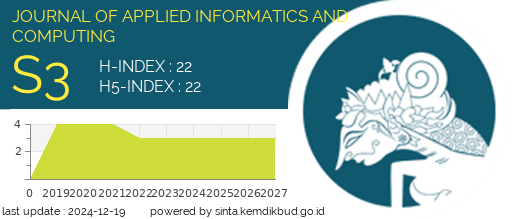Analysis of Digital Readiness in the Social Assistance Distribution System with the Unified Theory of Acceptance and Use of Technology (UTAUT)
DOI:
https://doi.org/10.30871/jaic.v9i2.9070Keywords:
UTAUT Model, Technology Adoption, Social Assistance, Digital Systems, Behavioral Intention, Actual UseAbstract
The adoption of digital systems for social assistance distribution has become increasingly vital in enhancing efficiency and accessibility. This study examines the acceptance of such a system using the Unified Theory of Acceptance and Use of Technology (UTAUT) model, analyzing six key constructs: Performance Expectancy (PE), Effort Expectancy (EX), Social Influence (SI), Facilitating Conditions (FC), Behavioral Intention (BI), and Actual Use (AU). A total of 150 respondents participated in the survey, providing insights into their perceptions of the system. The findings indicate that Performance Expectancy (4.2) received the highest mean score, demonstrating that users perceive the system as beneficial in improving efficiency. Effort Expectancy (4.0) suggests that the system is easy to use, while Social Influence (3.8) highlights the moderate role of external encouragement. Facilitating Conditions (3.9) reveal the availability of infrastructure but also suggest areas for improvement. Additionally, Behavioral Intention (4.1) and Actual Use (4.0) indicate strong user commitment toward system utilization. The study contributes to the understanding of digital technology adoption in social welfare programs and provides recommendations for optimizing system implementation. Future research should explore the long-term impact of digital adoption, assess its effectiveness in different demographic groups, and integrate qualitative insights to deepen the understanding of user experiences. Additionally, expanding the analysis to include external factors such as policy support, economic conditions, and digital literacy could further enhance the model’s applicability.
Downloads
References
[1] R. Abbas and K. Michael, Theoryhub book. 2022.
[2] F. Davis and P. Warshaw, “User Acceptance of Computer Technology: A Comparison of Two Theoretical Models,” Manage. Sci., vol. 35, pp. 982–1003, Aug. 1989, doi: 10.1287/mnsc.35.8.982.
[3] G. Ilieva et al., “Factors Influencing User Perception and Adoption of E-Government Services,” Adm. Sci., vol. 14, p. 54, Mar. 2024, doi: 10.3390/admsci14030054.
[4] S. Majapahit, “The Assessing Cimenyan Village’s IT Readiness for Digital Transformation in West Java,” J. Inf. Syst. Informatics, vol. 5, no. 4 SE-Articles, Dec. 2023, doi: 10.51519/journalisi.v5i4.582.
[5] M. Zeebaree, M. Agoyi, and M. Aqel, “Sustainable Adoption of E-Government from the UTAUT Perspective,” 2022. doi: 10.3390/su14095370.
[6] K. Szymaniec-Mlicka, “The Utaut Concept In Public Organizations – Results Of An Empirical Study,” Humanit. Soc. Sci. Q., vol. 31, pp. 145–152, Sep. 2024, doi: 10.7862/rz.2024.hss.37.
[7] K. Ofosu-Ampong, A. Asmah, J. A. Kani, and D. Bibi, “Determinants of digital technologies adoption in government census data operations,” Digit. Transform. Soc., vol. 2, no. 3, pp. 293–315, 2023, doi: 10.1108/DTS-11-2022-0056.
[8] V. E. Tobing-David, I. R. Adi, and M. Nuryana, “Conditions of Sustainable Welfare: A Cross-Case Empirical Analysis of 22 Locality-Based Welfare Systems in Decentralised Indonesia,” 2024. doi: 10.3390/su16041629.
[9] N. Adel, “The Impact of Digital Literacy and Technology Adoption on Financial Inclusion: Evidence from Emerging Economies in Africa, Asia, and Latin America,” Heliyon, vol. 10, no. 24, p. e40951, 2024, doi: 10.1016/j.heliyon.2024.e40951.
[10] A. Haleem, M. Javaid, M. A. Qadri, and R. Suman, “Understanding the role of digital technologies in education: A review,” Sustain. Oper. Comput., vol. 3, no. May, pp. 275–285, 2022, doi: 10.1016/j.susoc.2022.05.004.
[11] H. Ćetojević, “The Impact Of Digital Literacy On The Development Of Higher Education,” Педагошка стварност, vol. 69, pp. 189–192, Jan. 2024.
[12] L. Xue, A. M. Rashid, and S. Ouyang, “The Unified Theory of Acceptance and Use of Technology (UTAUT) in Higher Education: A Systematic Review,” Sage Open, vol. 14, no. 1, p. 21582440241229570, Jan. 2024, doi: 10.1177/21582440241229570.
[13] F. Amelia and S. Syaefulloh, “Analisis Penerapan Model UTAUT (Unified Theory of Acceptance and Use of Technology) Terhadap Perilaku Pengguna Sistem Informasi (Studi Kasus: Sistem Informasi Akademik Universitas di Pekanbaru),” Al Qalam J. Ilm. Keagamaan dan Kemasyarakatan, vol. 17, p. 3853, Nov. 2023, doi: 10.35931/aq.v17i6.2817.
[14] Z. Y. Pamungkas and A. Sudiarno, “Implementasi Model UTAUT (Unified Theory of Acceptance and Use of Technology) untuk Menganalisis Faktor- Faktor yang Mempengaruhi Penggunaan Aplikasi Brimo,” J. Teknol. Inf. dan Ilmu Komput., vol. 9, no. 3, pp. 569–578, 2022, doi: 10.25126/jtiik.2022936047.
[15] A. A. H. Zaid Kilani, D. F. Kakeesh, G. A. Al-Weshah, and M. M. Al-Debei, “Consumer post-adoption of e-wallet: An extended UTAUT2 perspective with trust,” J. Open Innov. Technol. Mark. Complex., vol. 9, no. 3, p. 100113, 2023, doi: 10.1016/j.joitmc.2023.100113.
[16] Z. Taibah and D. Rahmayanti, “Analysis of Intention to Use E-Wallet Dana with the Utaut Approach and Perceived Risk,” East Asian J. Multidiscip. Res., vol. 3, no. 3, pp. 1197–1212, 2024, [Online]. Available: https://journal.formosapublisher.org/index.php/eajmr
[17] H. Rençber, “United theory of acceptance and use of technology,” Consum. Behav. Model., pp. 181–192, 2020, doi: 10.1007/978-3-030-10576-1_300692.
Downloads
Published
How to Cite
Issue
Section
License
Copyright (c) 2025 Soni Adiyono, Noor Latifah, Diana Laily Fithri

This work is licensed under a Creative Commons Attribution-ShareAlike 4.0 International License.
Authors who publish with this journal agree to the following terms:
- Authors retain copyright and grant the journal right of first publication with the work simultaneously licensed under a Creative Commons Attribution License (Attribution-ShareAlike 4.0 International (CC BY-SA 4.0) ) that allows others to share the work with an acknowledgement of the work's authorship and initial publication in this journal.
- Authors are able to enter into separate, additional contractual arrangements for the non-exclusive distribution of the journal's published version of the work (e.g., post it to an institutional repository or publish it in a book), with an acknowledgement of its initial publication in this journal.
- Authors are permitted and encouraged to post their work online (e.g., in institutional repositories or on their website) prior to and during the submission process, as it can lead to productive exchanges, as well as earlier and greater citation of published work (See The Effect of Open Access).











